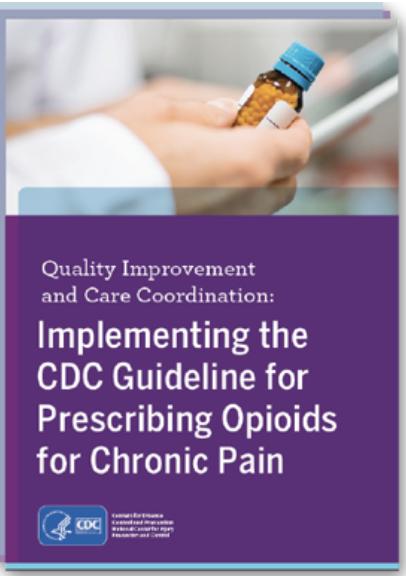
Responding to medical experts, including the American Medical Association, who have been complaining for years that the Center for Disease Control and Prevention’s 2016 Guideline for Prescribing Opioids for Chronic Pain lacked a strong basis in the evidence—and after it issued an Advisory in 2019 stating the Guideline was misinterpreted and “misapplied” by state lawmakers and health care practitioners—the CDC announced it was going to revise the Guideline before the end of 2022. Unfortunately, 38 states have already cast the flawed 2016 Guideline in stone by enshrining—and misapplying—all or part of it in statutes that dictate how health care practitioners may treat patients in pain.
In February of this year, the CDC released a draft of the revised Guideline and requested comments. I provided my comments here. In those comments, I stated. “Notwithstanding the well‐intentioned exhortations and disclaimer in the draft 2022 opioid prescribing guideline, the recommendations change very little from those put forth in 2016.”
The CDC goes to great lengths to stress throughout the draft 2022 Guideline that the document is meant to serve as a list of suggestions and recommendations and is by no means intended as a mandate, emphasizing that physicians should use their best clinical judgment to provide individualized treatment to their patients. However, I commented, “The CDC guideline will inevitably become interpreted and adopted as hard and fast rules by state and local governments, pharmacies, health plans, and third‐party payers, despite guideline warnings against doing so.”
I also criticized the draft for suggesting dosages based on “morphine milligram equivalents” of opioids:
For example, the guidelines still rely on Morphine Milligram Equivalent (MME) dose recommendations, even though there is no pharmacologic or biochemical basis for relying on equianalgesic conversion factors.
The use of MME conversion tables is nothing more than junk science. As Dr. Nabarun Dasgupta of the University of North Carolina Injury Prevention Center has written:
Contrary to conventional wisdom, conversion values are not based on pharmacologic properties. Instead, they arose 60 years ago from small single‐dose clinical studies in postoperative or cancer populations with pain score outcomes; toxicologic effects (e.g., respiratory depression) were not evaluated.
On November 3, the CDC published the final version of the 2022 Clinical Practice Guideline for Prescribing Opioids for Pain. The Guideline no longer recommends MME dosage thresholds, but it still urges practitioners to be cautious about prescribing more than 50 morphine milligram equivalents of opioids per day, stating :
Many patients do not experience benefit in pain or function from increasing opioid dosages to ≥50 MME/day but are exposed to progressive increases in risk as dosage increases. Therefore, before increasing total opioid dosage to ≥50 MME/day, clinicians should pause and carefully reassess evidence of individual benefits and risks. If a decision is made to increase dosage, clinicians should use caution and increase dosage by the smallest practical amount.
To prevent the recommendation from being “misapplied,” the Guideline adds the following disclaimer to the above paragraph:
The recommendations related to opioid dosages are not intended to be used as an inflexible, rigid standard of care; rather, they are intended to be guideposts to help inform clinician‐patient decision‐making.
Alas, the 2022 Guideline still includes the now‐discredited MME conversion table that providers can refer to when prescribing opioids.
The Guideline recommendations are still primarily based on “Type 3” and “Type 4” evidence, evidence with important limitations.
If the past is prologue, expect the Guideline’s suggestion to use caution approaching a dose of 50 MME to morph into another de facto mandate as lawmakers, pharmacies, and insurance plans fixate on that number. As Josh Bloom and I have written before:
When a government agency “recommends” a policy, it’s akin to a recommendation from Tony Soprano; it is inevitably interpreted as a mandate, obeyed by state and federal agencies, health insurers, and even pharmacies.
Perhaps most egregiously, the rationale of the 2022 Guideline remains predicated on the flawed assumption that overprescribing opioids caused the overdose crisis. There is no correlation between prescription volume and the nonmedical use or addiction to prescription opioids. And the percentage of people aged 18 or older addicted to prescription pain pills has been unchanged at less than one percent this entire century. The CDC should follow the evidence and abandon this mistaken premise.
Finally, as I concluded in my comments on the draft proposal back in February 2022:
1. The Centers for Disease Control and Prevention should not be issuing opioid prescribing guidelines. Professional specialty organizations, overseen by practicing clinicians and clinical educators, are the institutions that should be issuing standard of care and best practices guidelines.
2. The CDC guideline will inevitably become interpreted and adopted as hard and fast rules by state and local governments, pharmacies, health plans, and third‐party payers, despite guideline warnings against doing so.
3. The 2022 guideline very closely resembles the 2016 guideline and is based on weak evidence; in the case of Morphine Milligram Equivalent recommendations, the guideline is pharmacologically unsound, and the conversion tables are based largely on decades‐old subjective studies that didn’t even examine toxicologic effects such as respiratory depression rates.
4. The overdose crisis is largely caused by a growing population of nonmedical drug users intersecting with increasingly dangerous drugs being developed for the black market fueled by drug prohibition. Efforts to address the problem through reductions in opioid prescribing have only exacerbated the situation by driving nonmedical users to more dangerous drugs while depriving pain patients of necessary relief.
5. The Centers for Disease Control and Prevention should abandon its efforts to establish a prescribing guideline and defer to the professional institutions usually charged with establishing best practices.
Nothing in the just‐published Guideline makes me want to reconsider that conclusion.
#Reprinted with permission. Dr. Singer's original blog post can be read here.



